8 of the Most Resistant Tropical Fish for Aquariums
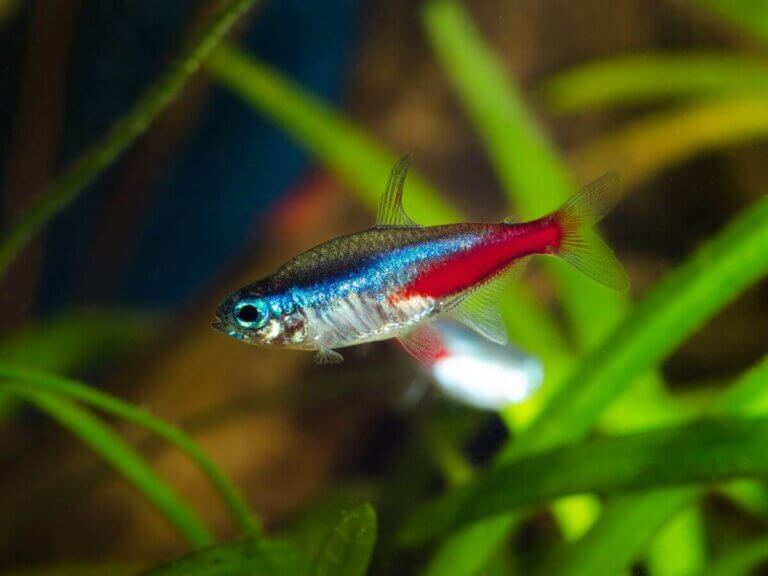

Written and verified by the veterinarian and zootechnician Sebastian Ramirez Ocampo
In the vast world of aquarium keeping, there are certain tropical species that stand out for their ability to tolerate temperature changes and variations in water quality, as well as different infectious diseases. Thanks to this, these fish have earned the reputation of being easy to care for, making them ideal for anyone who wants to get started in this practice. Want to know more about the most resistant tropical fish for aquariums?
In the following article, we’ll explore the classification and characteristics of the most resistant tropical fish for an aquarium. This way, you’ll be able to choose not only the most eye-catching ones but also those that best suit your needs and experience, so be sure to read to the end to discover what your new ideal pet will be!
How are tropical fish classified for an aquarium?
As their name suggests, tropical fish are those species that come from the warmest regions of the planet. In nature, they inhabit different aquatic environments, which include the following:
- Rivers
- Lakes
- Seas
They’re characterized by exhibiting exotic shapes and eye-catching colors.
According to the book Clinical Veterinary Advisor: Birds and Exotic Pets, tropical aquarium species can be classified as follows:
- Freshwater fish: They have a preference for temperatures between 75.2 °F to 80.6 °F. In addition, they demand a good dissolved oxygen content (6 mg/L) and a neutral pH (7.0).
- Saltwater fish: Are more sensitive to temperature changes than freshwater species. Optimal ranges are between 77.9 °F to 84.2 °F. They also need the same levels of dissolved oxygen, but prefer a basic pH (8.0 to 8.5).
At the same time, according to an article in the journal The Veterinary Clinics of North America, it’s also possible to differentiate them according to their feeding habits:
- Carnivores: They feed on worms, snails, fish, and small crustaceans, such as artemia. Their diet should be composed of 60% protein, 15% fat, 15% carbohydrates, and 10% fiber.
- Herbivores: Their diet is based on plants and algae. Their diet should consist of 40% protein, 15% fat, 40% carbohydrates, and 5% fiber.
- Omnivores: They can feed on animals and plants as well as commercial diets. Like herbivores, their diet should be based on 40% protein, 15% fat, 40% carbohydrates, and 5% fiber.
What are the most resistant tropical fish for an aquarium?
In accordance with the above classification, the most resistant tropical fish for an aquarium will be described below, according to the habitat from which they originate.
Freshwater fish
As stated in the book Manual of Exotic Pet Practice, freshwater fish are the most common species in aquariums around the world. They’re easy to care for and don’t require a large investment of resources to ensure their survival. They include several families:
- Guramis
- Caraccidae
- Cyprinids
- Catfishes
1. Neon tetra
This species, pictured in this article’s main image, belongs to the Characidae family (Characidae). Its elongated and flat body measures between 2 to 4 centimeters in adulthood. It exhibits strong and striking colors that are composed of a fluorescent bluish dorsal stripe and an intense orange ventral stripe.
Being omnivorous, neon tetra can eat a wide variety of foods:
- Worms
- Vegetables
- Water fleas
- Commercial diets
- Mosquito larvae
Regarding its behavior, the neon tetra fish prefers to live with several of its species. For this reason, it’s important to include at least 12 individuals so that they can socialize and develop properly.
In addition to its beauty, it’s one of the most resistant tropical fish for an aquarium, making it an excellent option for those who wish to start breeding ornamental species.
2. Guppy
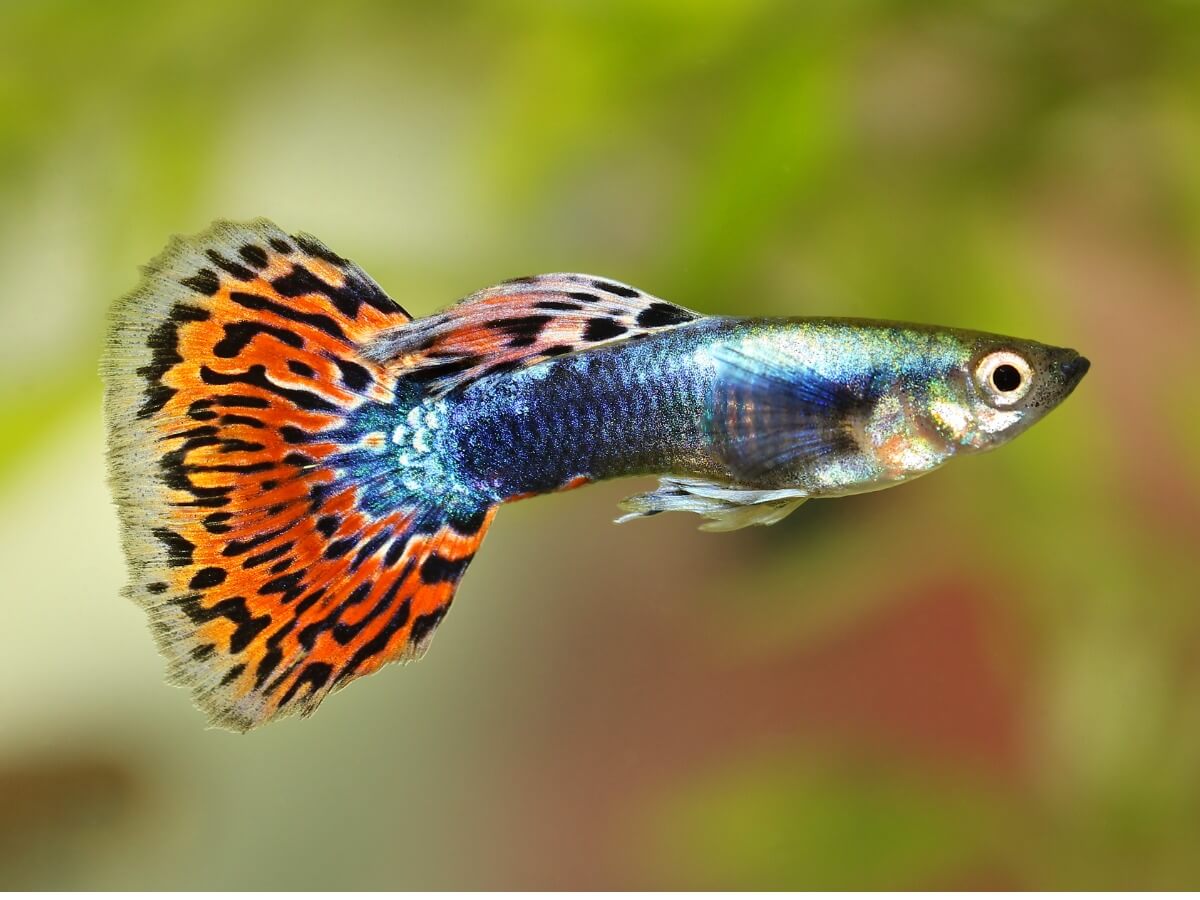
- Rounded
- Pointed shape
- Similar to a fan
In addition to this, they exhibit different metallic colorations that are very striking to the eye.
The guppy fish is omnivorous, therefore, it can eat a variety of foods:
- Plants
- Flakes
- Live or frozen animals
Both in the wild and in aquariums, they like to live in groups of several fish. In addition, they get along well with other species, such as tetras or gouramis.
3. Betta fish

Another popular and hardy tropical fish is the betta fish. Also known as the Siamese fighting fish, this species belongs to the family of osphronemids(Osphronemidae) or gouramis. They have gained a lot of prominence in recent years, as they possess incredible beauty. Their long fins provide a captivating and hypnotic effect when swimming, in addition to the vibrant colors that adorn their entire body.
They reach more than 2.4 inches in adulthood and can be fed with both commercial diets and live or frozen animals.
To ensure proper coexistence and survival of the species, the mixing of two males in the same pond should be avoided. Otherwise, both will fight for territory until one is badly injured or even killed. Despite this, bettas don’t have problems with females or with other fish such as guppies or tetras.
4. Harlequin
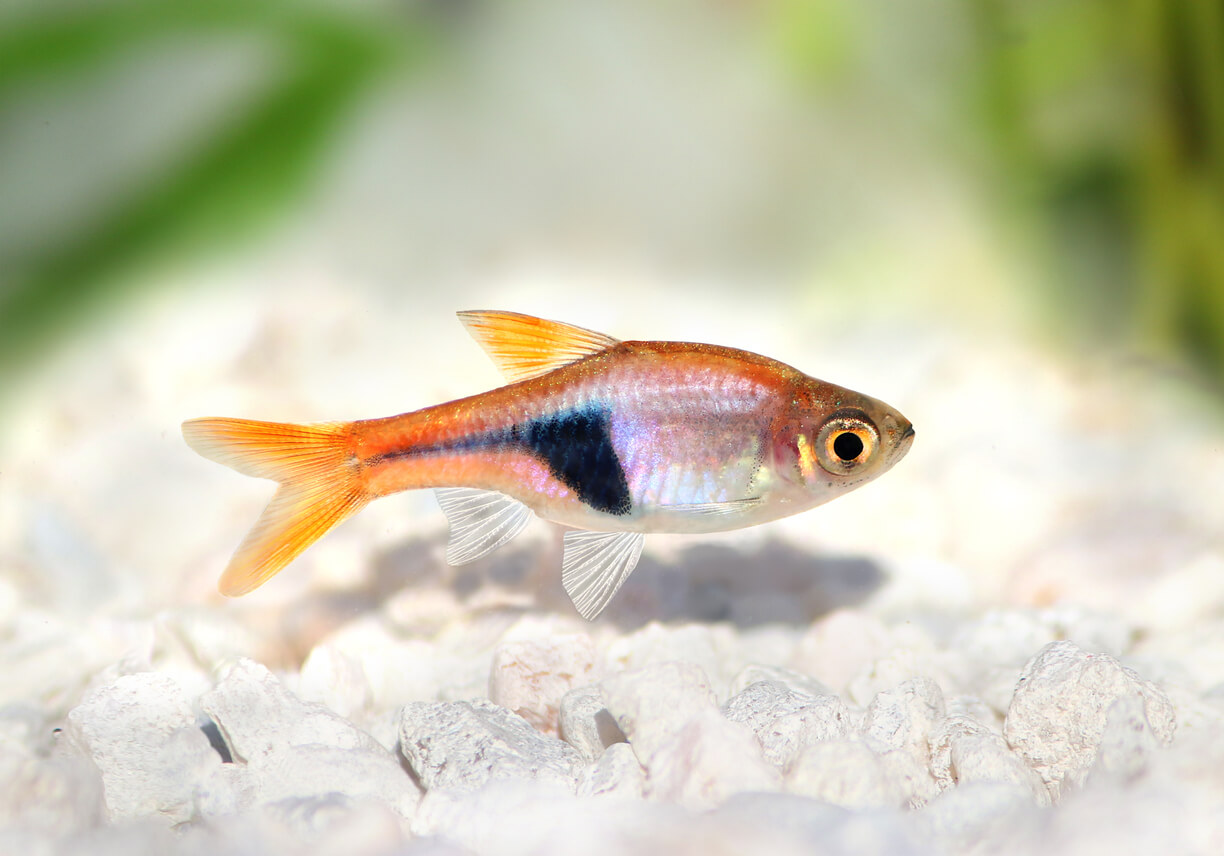
Because it’s one of the most resistant and easiest tropical fish to care for, it’s a highly recommended species for novice breeders. It belongs to the family of cyprinids (Cyprinidae), a group that also includes carp and the famous goldfish.
It is a small fish, not exceeding 2 inches in adulthood.
Its body has an orange coloration that dilutes towards the center, with a black stripe covering part of its abdomen. Being omnivorous, diversity characterizes its diet:
- Larvae
- Crustaceans
- Small insects
- Commercial flake diets
At the same time, it’s a gregarious species, so it needs to live with at least ten specimens in its aquarium. In addition, they need ample space and plants that favor their behavior in nature.
5. Catfish
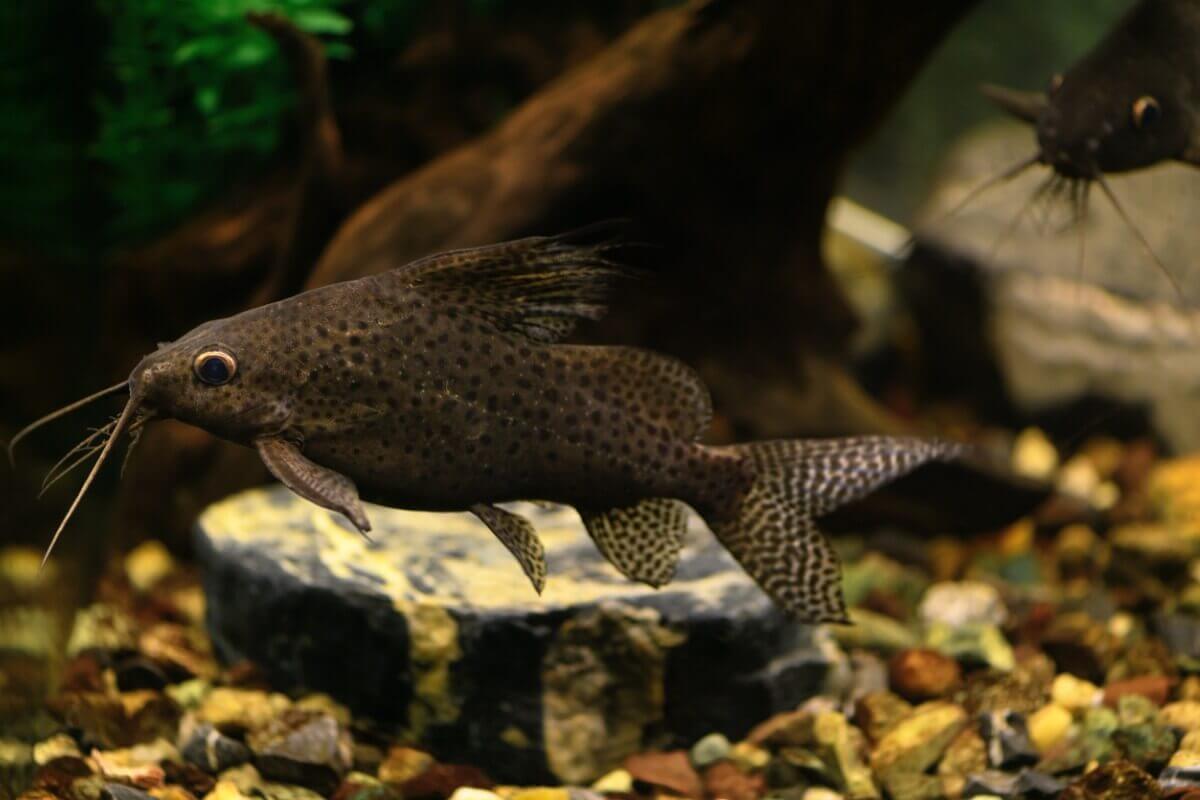
The catfish group consists of more than 2,000 species, and they’re distributed in all fresh waters of the planet. For their hardiness and longevity, species of the corydoras family (Callichthyidae) are recommended, especially the peppered cory fish.
It’s a small fish, about 1 to 3 inches long, and is usually opaque gray in color.
Like all catfishes, it has two barbels protruding from its mouth, which it uses to absorb odors and explore the environment. In addition, it has a series of bony plates that protect its body from head to tail. Its feeding habits are those of an omnivorous and limnivorous animal, as it feeds on substances that fall to the bottom of the aquarium. Because of this ability, they’re considered excellent pond cleaners.
They are friendly fish that coexist well with guppies, tetras, rainbow fish, and other ornamental species. They’re usually found near the bottom of the aquarium.
Saltwater fish
According to the Manual of Exotic Pet Practice mentioned above, there are approximately 23 categories of marine or saltwater fish. Among them, we can find four subcategories that are classified according to their feeding behaviors and coexistence with other fish:
- Fast eaters: These are territorial fish that show aggressive behavior when feeding. It’s best for them to coexist in low densities and for their diet to be diverse. Some of the species in this group are angelfish, damselfish, and squirrelfish.
- Slow feeders: They require ample space in their aquarium and places to hide. They also need a varied diet. Species such as clownfish, parrotfish, and pufferfish belong to this group.
- They don’t compete for food: Fish in this subcategory are very passive when it comes to feeding. They should be kept in aquariums with others of the same group and should be monitored so that they consume the necessary calories. Among the species that belong to this category are seahorses and pipefishes.
- Gluttons: These fish have a voracious and insatiable appetite and are also territorial. These include snappers and grunts.
Having clarified this point, we’ll now go on to describe the most resistant tropical fish for a saltwater aquarium.
6. Clownfish
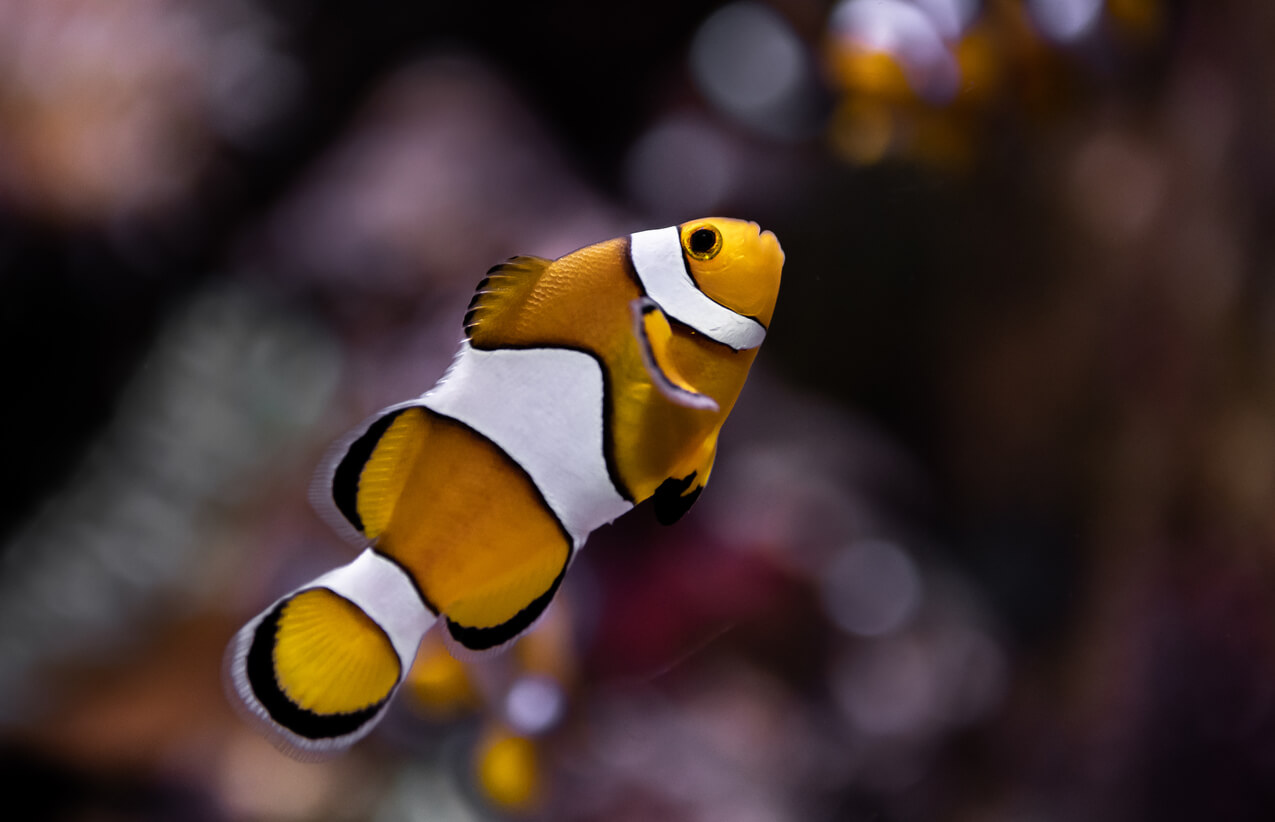
It’s perhaps one of the most recognized fish due to its appearances in several animated movies. It stands out for several reasons:
- Resilience
- Easy adaptability
- The ability to reproduce in captivity
As adults, they usually reach 4.3 inches in length and have a sttiped pattern that combines several colors:
- Black
- White
- Orange
Being an omnivorous animal, it’s possible to feed it with granulated food made specifically for this fish, as well as plants and small crustaceans, such as artemia.
At the same time, it’s a sociable species that has no problem living with other individuals, including other types of fish. In fact, it needs a group to develop normally.
7. Angelfish
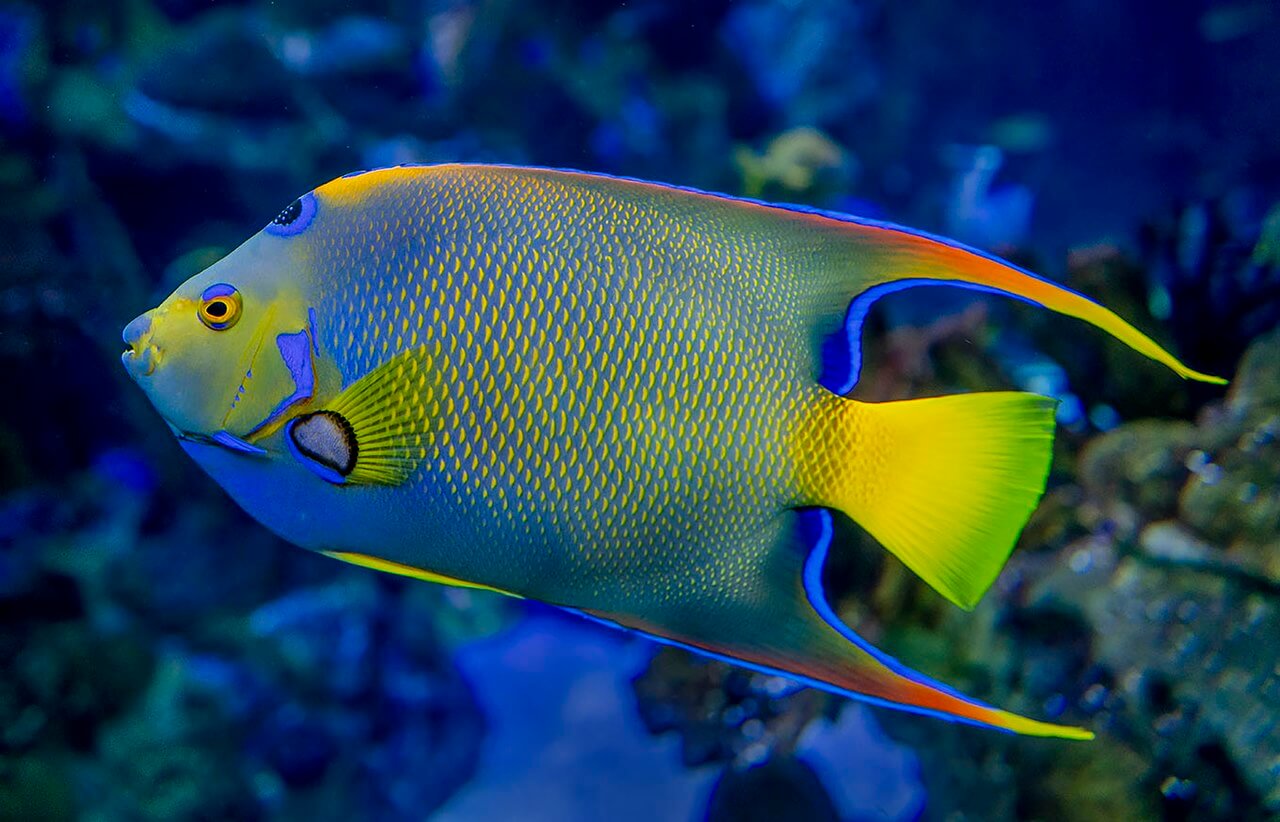
Also known as scalar fish, it’s a species that can be found in both freshwater and marine ecosystems. It belongs to the cichlid family and can measure up to 12 inches long. Saltwater species stand out for their bright and striking colors, grouped in shades that give life to different patterns:
- Blues
- Black
- Yellow
In the aquarium, they can be fed algae or small live or frozen crustaceans. Although angelfish are docile fish that have no difficulty living with other individuals, caution should be taken with small fish, as they could serve as food for the angelfish due to their difference in size.
8. Green damselfish
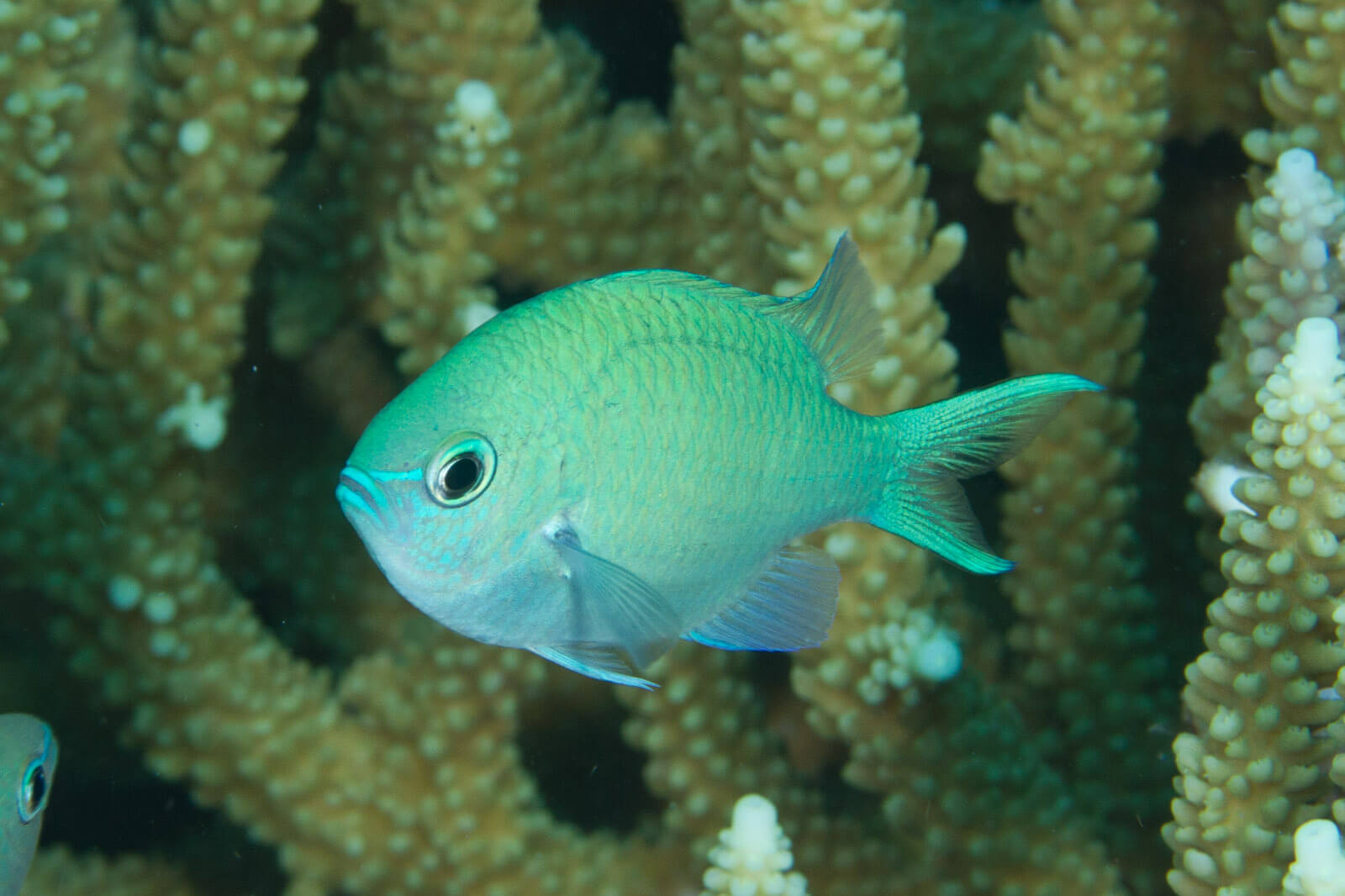
This is a species that has earned a reputation as one of the most resistant tropical fish for an aquarium. This is due to its great adaptability and resistance to adverse conditions. It comes from the Pomacentrid family(Pomacentridae), just like the clownfish. It’s a small fish, with sizes between 2.4 and 3.2 inches. On the other hand, as its name indicates, it has an aquamarine green color throughout its body, with some shades of blue.
Its diet should be that of an omnivorous fish. As it’s a fast-eating fish, its diet should be varied:
- Algae
- Frozen crustaceans
- Commercial flake food
In terms of sociability, the green damselfish is a peaceful and gregarious fish that enjoys the company of other species. However, if the aquarium is small, there should be only one male, as if there are more than one, they may fight for territory.
Although hardy, they still need your care
Although these fish stand out from the rest due to their adaptability and their resistance to environmental changes and disease attacks, it’s important to remember that they need the minimum care required by any aquatic species.
Therefore, controlling the temperature, pH, oxygen concentration, and other water parameters is essential to ensure their survival and enjoy their company for several years.
If you’re a beginner aquarium keeper, we recommend that you start with any of these species. This way, you’ll be able to consolidate your knowledge and acquire the necessary experience to include much more delicate but equally beautiful fish. Now that you know them, what are you waiting for to enter the fascinating world of aquarium keeping?
Main photo credit: iStockphoto.
In the vast world of aquarium keeping, there are certain tropical species that stand out for their ability to tolerate temperature changes and variations in water quality, as well as different infectious diseases. Thanks to this, these fish have earned the reputation of being easy to care for, making them ideal for anyone who wants to get started in this practice. Want to know more about the most resistant tropical fish for aquariums?
In the following article, we’ll explore the classification and characteristics of the most resistant tropical fish for an aquarium. This way, you’ll be able to choose not only the most eye-catching ones but also those that best suit your needs and experience, so be sure to read to the end to discover what your new ideal pet will be!
How are tropical fish classified for an aquarium?
As their name suggests, tropical fish are those species that come from the warmest regions of the planet. In nature, they inhabit different aquatic environments, which include the following:
- Rivers
- Lakes
- Seas
They’re characterized by exhibiting exotic shapes and eye-catching colors.
According to the book Clinical Veterinary Advisor: Birds and Exotic Pets, tropical aquarium species can be classified as follows:
- Freshwater fish: They have a preference for temperatures between 75.2 °F to 80.6 °F. In addition, they demand a good dissolved oxygen content (6 mg/L) and a neutral pH (7.0).
- Saltwater fish: Are more sensitive to temperature changes than freshwater species. Optimal ranges are between 77.9 °F to 84.2 °F. They also need the same levels of dissolved oxygen, but prefer a basic pH (8.0 to 8.5).
At the same time, according to an article in the journal The Veterinary Clinics of North America, it’s also possible to differentiate them according to their feeding habits:
- Carnivores: They feed on worms, snails, fish, and small crustaceans, such as artemia. Their diet should be composed of 60% protein, 15% fat, 15% carbohydrates, and 10% fiber.
- Herbivores: Their diet is based on plants and algae. Their diet should consist of 40% protein, 15% fat, 40% carbohydrates, and 5% fiber.
- Omnivores: They can feed on animals and plants as well as commercial diets. Like herbivores, their diet should be based on 40% protein, 15% fat, 40% carbohydrates, and 5% fiber.
What are the most resistant tropical fish for an aquarium?
In accordance with the above classification, the most resistant tropical fish for an aquarium will be described below, according to the habitat from which they originate.
Freshwater fish
As stated in the book Manual of Exotic Pet Practice, freshwater fish are the most common species in aquariums around the world. They’re easy to care for and don’t require a large investment of resources to ensure their survival. They include several families:
- Guramis
- Caraccidae
- Cyprinids
- Catfishes
1. Neon tetra
This species, pictured in this article’s main image, belongs to the Characidae family (Characidae). Its elongated and flat body measures between 2 to 4 centimeters in adulthood. It exhibits strong and striking colors that are composed of a fluorescent bluish dorsal stripe and an intense orange ventral stripe.
Being omnivorous, neon tetra can eat a wide variety of foods:
- Worms
- Vegetables
- Water fleas
- Commercial diets
- Mosquito larvae
Regarding its behavior, the neon tetra fish prefers to live with several of its species. For this reason, it’s important to include at least 12 individuals so that they can socialize and develop properly.
In addition to its beauty, it’s one of the most resistant tropical fish for an aquarium, making it an excellent option for those who wish to start breeding ornamental species.
2. Guppy

- Rounded
- Pointed shape
- Similar to a fan
In addition to this, they exhibit different metallic colorations that are very striking to the eye.
The guppy fish is omnivorous, therefore, it can eat a variety of foods:
- Plants
- Flakes
- Live or frozen animals
Both in the wild and in aquariums, they like to live in groups of several fish. In addition, they get along well with other species, such as tetras or gouramis.
3. Betta fish

Another popular and hardy tropical fish is the betta fish. Also known as the Siamese fighting fish, this species belongs to the family of osphronemids(Osphronemidae) or gouramis. They have gained a lot of prominence in recent years, as they possess incredible beauty. Their long fins provide a captivating and hypnotic effect when swimming, in addition to the vibrant colors that adorn their entire body.
They reach more than 2.4 inches in adulthood and can be fed with both commercial diets and live or frozen animals.
To ensure proper coexistence and survival of the species, the mixing of two males in the same pond should be avoided. Otherwise, both will fight for territory until one is badly injured or even killed. Despite this, bettas don’t have problems with females or with other fish such as guppies or tetras.
4. Harlequin

Because it’s one of the most resistant and easiest tropical fish to care for, it’s a highly recommended species for novice breeders. It belongs to the family of cyprinids (Cyprinidae), a group that also includes carp and the famous goldfish.
It is a small fish, not exceeding 2 inches in adulthood.
Its body has an orange coloration that dilutes towards the center, with a black stripe covering part of its abdomen. Being omnivorous, diversity characterizes its diet:
- Larvae
- Crustaceans
- Small insects
- Commercial flake diets
At the same time, it’s a gregarious species, so it needs to live with at least ten specimens in its aquarium. In addition, they need ample space and plants that favor their behavior in nature.
5. Catfish

The catfish group consists of more than 2,000 species, and they’re distributed in all fresh waters of the planet. For their hardiness and longevity, species of the corydoras family (Callichthyidae) are recommended, especially the peppered cory fish.
It’s a small fish, about 1 to 3 inches long, and is usually opaque gray in color.
Like all catfishes, it has two barbels protruding from its mouth, which it uses to absorb odors and explore the environment. In addition, it has a series of bony plates that protect its body from head to tail. Its feeding habits are those of an omnivorous and limnivorous animal, as it feeds on substances that fall to the bottom of the aquarium. Because of this ability, they’re considered excellent pond cleaners.
They are friendly fish that coexist well with guppies, tetras, rainbow fish, and other ornamental species. They’re usually found near the bottom of the aquarium.
Saltwater fish
According to the Manual of Exotic Pet Practice mentioned above, there are approximately 23 categories of marine or saltwater fish. Among them, we can find four subcategories that are classified according to their feeding behaviors and coexistence with other fish:
- Fast eaters: These are territorial fish that show aggressive behavior when feeding. It’s best for them to coexist in low densities and for their diet to be diverse. Some of the species in this group are angelfish, damselfish, and squirrelfish.
- Slow feeders: They require ample space in their aquarium and places to hide. They also need a varied diet. Species such as clownfish, parrotfish, and pufferfish belong to this group.
- They don’t compete for food: Fish in this subcategory are very passive when it comes to feeding. They should be kept in aquariums with others of the same group and should be monitored so that they consume the necessary calories. Among the species that belong to this category are seahorses and pipefishes.
- Gluttons: These fish have a voracious and insatiable appetite and are also territorial. These include snappers and grunts.
Having clarified this point, we’ll now go on to describe the most resistant tropical fish for a saltwater aquarium.
6. Clownfish

It’s perhaps one of the most recognized fish due to its appearances in several animated movies. It stands out for several reasons:
- Resilience
- Easy adaptability
- The ability to reproduce in captivity
As adults, they usually reach 4.3 inches in length and have a sttiped pattern that combines several colors:
- Black
- White
- Orange
Being an omnivorous animal, it’s possible to feed it with granulated food made specifically for this fish, as well as plants and small crustaceans, such as artemia.
At the same time, it’s a sociable species that has no problem living with other individuals, including other types of fish. In fact, it needs a group to develop normally.
7. Angelfish

Also known as scalar fish, it’s a species that can be found in both freshwater and marine ecosystems. It belongs to the cichlid family and can measure up to 12 inches long. Saltwater species stand out for their bright and striking colors, grouped in shades that give life to different patterns:
- Blues
- Black
- Yellow
In the aquarium, they can be fed algae or small live or frozen crustaceans. Although angelfish are docile fish that have no difficulty living with other individuals, caution should be taken with small fish, as they could serve as food for the angelfish due to their difference in size.
8. Green damselfish

This is a species that has earned a reputation as one of the most resistant tropical fish for an aquarium. This is due to its great adaptability and resistance to adverse conditions. It comes from the Pomacentrid family(Pomacentridae), just like the clownfish. It’s a small fish, with sizes between 2.4 and 3.2 inches. On the other hand, as its name indicates, it has an aquamarine green color throughout its body, with some shades of blue.
Its diet should be that of an omnivorous fish. As it’s a fast-eating fish, its diet should be varied:
- Algae
- Frozen crustaceans
- Commercial flake food
In terms of sociability, the green damselfish is a peaceful and gregarious fish that enjoys the company of other species. However, if the aquarium is small, there should be only one male, as if there are more than one, they may fight for territory.
Although hardy, they still need your care
Although these fish stand out from the rest due to their adaptability and their resistance to environmental changes and disease attacks, it’s important to remember that they need the minimum care required by any aquatic species.
Therefore, controlling the temperature, pH, oxygen concentration, and other water parameters is essential to ensure their survival and enjoy their company for several years.
If you’re a beginner aquarium keeper, we recommend that you start with any of these species. This way, you’ll be able to consolidate your knowledge and acquire the necessary experience to include much more delicate but equally beautiful fish. Now that you know them, what are you waiting for to enter the fascinating world of aquarium keeping?
Main photo credit: iStockphoto.
All cited sources were thoroughly reviewed by our team to ensure their quality, reliability, currency, and validity. The bibliography of this article was considered reliable and of academic or scientific accuracy.
- Corcoran, M. (2015). Environmental enrichment for aquatic animals. The veterinary clinics of North America. Exotic Animal Practice, 18(2), 305–321. https://linkinghub.elsevier.com/retrieve/pii/S1094-9194(15)00005-5
- Mayer, J., & Donnelly, M. (2013). Clinical Veterinary Advisor: Birds and Exotic. Saunders. https://www.sciencedirect.com/science/article/abs/pii/B9781416039693000305
- Mitchell, M., & Tully, T. (2009). Manual of Exotic Pet Practice. Elsevier Inc. https://books.google.com.co/books?id=8R0_ni8bINAC&pg=PA39&hl=es&source=gbs_toc_r&cad=1#v=onepage&q&f=false
- Perry, S. (September 29, 2022). 5 Facts About Betta Fish. PetMD. Consultado el 29 de agosto de 2023. https://www.petmd.com/fish/care/evr_fi_facts-about-betta-fish
- Sanders, J. (January 05, 2023). Guppy Fish Species Profile. The Spruce Pets. Consultado el 29 de agosto de 2023. https://www.thesprucepets.com/guppy-fish-species-profile-5078901
- Sanders, J. (February 08, 2023). Ocellaris Clownfish: Fish Species Profile. The Spruce Pets. Consultado el 29 de agosto de 2023. https://www.thesprucepets.com/clowfish-fish-species-profile-6543005
- Sharpe, S. (August 30, 2022). Neon Tetra: Fish Species Profile. The Spruce Pets. Consultado el 29 de agosto de 2023. https://www.thesprucepets.com/neon-tetra-paracheirodon-1381835
- Sharpe, S. (May 30, 2022). 10 Best Angelfish for Freshwater Aquariums. The Spruce Pets. Consultado el 29 de agosto de 2023. https://www.thesprucepets.com/angelfish-gallery-4121742
- Yang, A. (July 20, 2023). Blue Green Chromis Care: The Complete Guide. Aquarium source. Consultado el 29 de agosto de 2023. https://www.aquariumsource.com/blue-green-chromis/
- Yang, A. (May 06, 2022). Harlequin Rasbora Care: Size, Tank Mates, Breeding & More. Aquarium source. Consultado el 29 de agosto de 2023. https://www.aquariumsource.com/harlequin-rasbora/
This text is provided for informational purposes only and does not replace consultation with a professional. If in doubt, consult your specialist.








